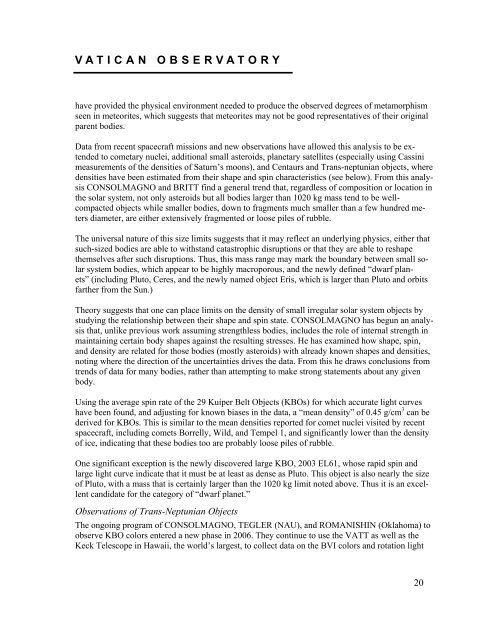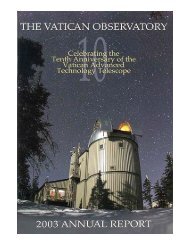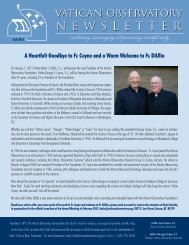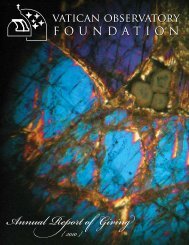06 VO annual report FINAL - Vatican Observatory
06 VO annual report FINAL - Vatican Observatory
06 VO annual report FINAL - Vatican Observatory
You also want an ePaper? Increase the reach of your titles
YUMPU automatically turns print PDFs into web optimized ePapers that Google loves.
VATICAN OBSERVATORY<br />
have provided the physical environment needed to produce the observed degrees of metamorphism<br />
seen in meteorites, which suggests that meteorites may not be good representatives of their original<br />
parent bodies.<br />
Data from recent spacecraft missions and new observations have allowed this analysis to be extended<br />
to cometary nuclei, additional small asteroids, planetary satellites (especially using Cassini<br />
measurements of the densities of Saturn’s moons), and Centaurs and Trans-neptunian objects, where<br />
densities have been estimated from their shape and spin characteristics (see below). From this analysis<br />
CONSOLMAGNO and BRITT find a general trend that, regardless of composition or location in<br />
the solar system, not only asteroids but all bodies larger than 1020 kg mass tend to be wellcompacted<br />
objects while smaller bodies, down to fragments much smaller than a few hundred meters<br />
diameter, are either extensively fragmented or loose piles of rubble.<br />
The universal nature of this size limits suggests that it may reflect an underlying physics, either that<br />
such-sized bodies are able to withstand catastrophic disruptions or that they are able to reshape<br />
themselves after such disruptions. Thus, this mass range may mark the boundary between small solar<br />
system bodies, which appear to be highly macroporous, and the newly defined “dwarf planets”<br />
(including Pluto, Ceres, and the newly named object Eris, which is larger than Pluto and orbits<br />
farther from the Sun.)<br />
Theory suggests that one can place limits on the density of small irregular solar system objects by<br />
studying the relationship between their shape and spin state. CONSOLMAGNO has begun an analysis<br />
that, unlike previous work assuming strengthless bodies, includes the role of internal strength in<br />
maintaining certain body shapes against the resulting stresses. He has examined how shape, spin,<br />
and density are related for those bodies (mostly asteroids) with already known shapes and densities,<br />
noting where the direction of the uncertainties drives the data. From this he draws conclusions from<br />
trends of data for many bodies, rather than attempting to make strong statements about any given<br />
body.<br />
Using the average spin rate of the 29 Kuiper Belt Objects (KBOs) for which accurate light curves<br />
have been found, and adjusting for known biases in the data, a “mean density” of 0.45 g/cm 3 can be<br />
derived for KBOs. This is similar to the mean densities <strong>report</strong>ed for comet nuclei visited by recent<br />
spacecraft, including comets Borrelly, Wild, and Tempel 1, and significantly lower than the density<br />
of ice, indicating that these bodies too are probably loose piles of rubble.<br />
One significant exception is the newly discovered large KBO, 2003 EL61, whose rapid spin and<br />
large light curve indicate that it must be at least as dense as Pluto. This object is also nearly the size<br />
of Pluto, with a mass that is certainly larger than the 1020 kg limit noted above. Thus it is an excellent<br />
candidate for the category of “dwarf planet.”<br />
Observations of Trans-Neptunian Objects<br />
The ongoing program of CONSOLMAGNO, TEGLER (NAU), and ROMANISHIN (Oklahoma) to<br />
observe KBO colors entered a new phase in 20<strong>06</strong>. They continue to use the VATT as well as the<br />
Keck Telescope in Hawaii, the world’s largest, to collect data on the BVI colors and rotation light<br />
20







